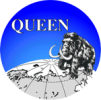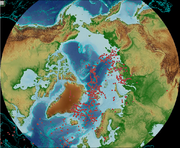.gif)
QUEEN (project)
Encyclopedia

QUEEN was established to understand the processes involved in environmental changes in the Arctic region by studying past environmental changes during the Late Cenozoic
Cenozoic
The Cenozoic era is the current and most recent of the three Phanerozoic geological eras and covers the period from 65.5 mya to the present. The era began in the wake of the Cretaceous–Tertiary extinction event at the end of the Cretaceous that saw the demise of the last non-avian dinosaurs and...
era. A primary objective of QUEEN was to make the environmental record and the history of glaciation during the last 250,000 years as complete for Eurasia as elsewhere. Regions of particular importance for understanding the Arctic
Arctic
The Arctic is a region located at the northern-most part of the Earth. The Arctic consists of the Arctic Ocean and parts of Canada, Russia, Greenland, the United States, Norway, Sweden, Finland, and Iceland. The Arctic region consists of a vast, ice-covered ocean, surrounded by treeless permafrost...
's role in global climate change are the Eurasian shelves and the land masses south of these, including Siberian permafrost
Permafrost
In geology, permafrost, cryotic soil or permafrost soil is soil at or below the freezing point of water for two or more years. Ice is not always present, as may be in the case of nonporous bedrock, but it frequently occurs and it may be in amounts exceeding the potential hydraulic saturation of...
. The ice sheets in these regions are key elements in paleoclimatic models and play a vital role in the reconstruction of a continuous paleoenvironmental record. Special effort was devoted to the correlation of records from different sources across the Arctic. The programme was running between 1996 and 2003 under the umbrella of the European Science Foundation
European Science Foundation
The European Science Foundation is an association of 78 member organisations devoted to scientific research in 30 European countries. It is an independent, non-governmental, non-profit organisation that facilitates cooperation and collaboration in European research and development, European...
(ESF) and was coordinated by Prof. Dr. Jörn Thiede.
Background
Global climate models have shown that the Arctic OceanArctic Ocean
The Arctic Ocean, located in the Northern Hemisphere and mostly in the Arctic north polar region, is the smallest and shallowest of the world's five major oceanic divisions...
and surrounding continental
areas are highly sensitive to the Greenhouse Effect
Greenhouse effect
The greenhouse effect is a process by which thermal radiation from a planetary surface is absorbed by atmospheric greenhouse gases, and is re-radiated in all directions. Since part of this re-radiation is back towards the surface, energy is transferred to the surface and the lower atmosphere...
. The temperature increase predicted by
such climate models would lead to a reduction in Arctic sea ice cover and the release of
further Greenhouse gases from Arctic soil
Soil
Soil is a natural body consisting of layers of mineral constituents of variable thicknesses, which differ from the parent materials in their morphological, physical, chemical, and mineralogical characteristics...
s. This in turn would have a major impact on the
European climate.
Associated changes in surface albedo and ocean-atmosphere heat and gas exchange
accelerate global warming, having a positive feedback effect. Increased temperatures of Arctic
surface waters affects the deep water renewal in the Nordic Seas and the
effectiveness of the global conveyor belt, which regulates the European climate through the
Nordic heat pump. Partial melting of the Greenland ice sheet from warming in the Arctic
induces a global sea level rise, increasing the danger of flooding in low lying regions close to
coasts all over the world.
The models predicting future climate change are tested and validated mainly against historical
climate data when the actual changes that subsequently occurred are known. To do this
accurately obviously requires detailed knowledge of what these past changes were. Although
the Arctic is known to have a key role in climate change, comparatively little is known about
extent and rates of Late Quaternary changes of climatically and oceanographically important
parameters in the Arctic.
Prior to QUEEN many projects were conducted in isolation, with little exchange of information between the institutions involved. Political changes in the late 198th/early 199th made it possible to exchange information freely between
Russian scientists and their colleagues from Western countries. All scientists had access
to the Russian Arctic, which comprises about half of the circum-Arctic land mass. As a result,
many projects looking at climatic and environmental changes during the recent geological past
were focusing on the Arctic as a whole. Among those, QUEEN was one of the first.
Objectives

- Investigation of environmental changes in the Eurasian Arctic over the past 250,000 years, i.e., the last two climatic cycles.
- Establish a record of palaeoenvironmental changes during this period on land,
on continental shelves, and in the deep sea of the Arctic Ocean along the Eurasian
continental margin.
- Correlate terrestrial, shelf and deep ocean records by using a variety of stratigraphic
tools and dating methods.
- Reconstruct ice-sheet growth and decay over this period from geological and
palaeontological evidence.
- Predict how sensitively ice sheets respond to climate change
through the glacial-interglacial cycles by numerical modeling.
- Study relative changes in sea level to build a map of corresponding
vertical movements of the underlying earth surface.
- Investigate how the depth of permafrost has responded to climatic and environmental
change.
- Use high resolution radiocarbon-dating for the environmental record of
the last glacial maximum and deglaciation (<30,000 yr BP).
Institutes involved
- Alfred Wegener Institute for Polar and Marine ResearchAlfred Wegener Institute for Polar and Marine ResearchThe Alfred Wegener Institute of Polar and Marine Research is a scientific organization located in Bremerhaven, Germany. The institute was founded in 1980 and is named after revolutionary meteorologist climatologist, and geologist Alfred Wegener...
(AWI), Bremerhaven - Arctic and Antarctic Research InstituteArctic and Antarctic Research InstituteThe Arctic and Antarctic Research Institute, or AARI is the oldest and largest Russian research institute in the field of comprehensive studies of Arctic and Antarctica...
(AARI), St. Petersburg - Department of Quaternary Geology, University of Lund
- Geological Museum, University of Copenhagen
- Geological Survey of Finland
- Geologisk Institutt, Universitet i Bergen
- Research Center for Marine Geosciences (GEOMAR), Kiel (renamed to Leibniz Institute of Marine Sciences) (IFM-GEOMAR)
- Institute of Earth Studies, University of Wales

